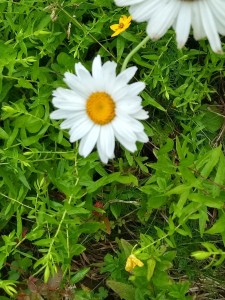 My house was built in 1882. Two years later, in 1884, botanist Luther Burbank (1849-1926) began to build a better daisy. Another seventeen years passed while Burbank crossed various daisy species. Finally, in 1901, he introduced a new ornamental plant named after Mount Shasta, one of California’s natural wonders. The Shasta daisy, Leucanthemum x superbum, was born, and today several healthy stands of them are blooming in my front garden.
My house was built in 1882. Two years later, in 1884, botanist Luther Burbank (1849-1926) began to build a better daisy. Another seventeen years passed while Burbank crossed various daisy species. Finally, in 1901, he introduced a new ornamental plant named after Mount Shasta, one of California’s natural wonders. The Shasta daisy, Leucanthemum x superbum, was born, and today several healthy stands of them are blooming in my front garden.
I didn’t think about the daisy’s historical appropriateness when I planted the first gallon pot fifteen years ago. I am gratified that in addition to looking spectacular at this time of year, Shastas are, historically, one of the best plants for my little home landscape.
Another corner of my garden contains a much smaller stand of Leucanthemum vulgare, the common ox-eye daisy, one of the parents of the Shasta. The ox-eye is a winsome plant, gangly at about eighteen inches tall, with narrow, dissected leaves and one and a half inch white-petaled flowers. You can find it in fields and other out-of-the-way places, and it is lovely in its own way Burbank, who also worked magic on potatoes, plums and a host of other species, was a great believer in the idea that everything could be made better through science, including the daisy. He created the “All-American” Shasta by crossing the ox-eye, which is native to Europe and parts of Asia, with other daisy species that originated in England, Portugal and Japan. All of these adventures in foreign affairs took place at Burbank’s home in Santa Rosa, California. Given its multi-national heritage, it is not surprising that the Shasta became a favorite worldwide.
Shastas are classic “pass along” plants because they are so easy to grow. Like their field daisy ancestors, they are not fussy about soil, and thrive in just about any sunny spot. Once established, they do not need a lot of supplemental water. The plants multiply rapidly into healthy clumps, but if the clumps grow too large, dividing is easy. Simply dig up the clump, divide the roots with a sharp spade or a garden utility knife and replant the divisions. Doing this every few years will keep the daisies healthy. When bloom time rolls around in late June or early July, pick the flowers or deadhead the plants to promote rebloom.
Over the years hybridizers have taken up Burbank’s “better daisy” crusade and created their own spins on the original. The number of new cultivars increases every year, with flashy new specimens replacing older ones on garden center pallets. One, ‘Chuck’s Delight’ is so special that it can only be obtained by visiting Luther Burbank’s Gold Ridge Experimental Farm in Sebastopol, California. Most others are more readily available.
If you can’t get to Sebastopol, consider going to the local nursery and picking up Leucanthemum x superbum ‘Becky’. ‘Becky’ has big, bright single flowers with crisp white petals and quarter-size yellow centers. It grows to be about three feet tall on sturdy stems that resist flopping. ‘Becky’ is such a stellar performer that the Perennial Plant Association named it their “Perennial Plant of the Year” way back in 2003.
Other, slightly shorter single-flowered varieties include ‘Alaska’, which reaches about twenty-four inches tall.
For smaller spaces or containers, try little ‘Tinkerbelle’, a dwarf variety that grows only eight inches tall and has single flowers. The slightly larger ‘Shortstop’, at 12 inches high, is another small space option. For full-size flowers on a relatively compact plant, try ‘Whoops A Daisy,’ which grows 16 inches tall.
For those who believe that nothing exceeds like excess, there are several double-flowered varieties of L. x superbum, not to mention more than a few that are beyond double, with flowerheads that look like the aftermath of a small explosion. The aptly named ‘Adorable’ is short at 10 to 14 inches tall with a double row of petals and a winsome corona of small yellow petaloids ringing the center. ‘Belgian Lace’, rising only 10 to 12 inches, features double rows of narrow, rather shaggy-looking white petals. It is similar to the equally frilly ‘Aglaia’, which may grow up to 24 inches tall.
For some hybridizers no combination of frills, quills, crests or triple petal rows is enough–color is what matters. ’Real Sunbeam’ substitutes sunny yellow petals for the white of more common varieties. Scrumptious ‘Banana Cream’ blooms in a softer, buttery shade that ages to ivory. I saw it for the first time, fell in love and moved it directly into my garden. I found a somewhat older variety, ‘Sunshine’ at a wonderful nursery in central New York State and installed it in the beach garden at my family’s summer cottage. For a yellow variety that looks more like a chrysanthemum, try ‘Lemon Puff’, with two-toned yellow blooms.
There are some people who would probably say, “A daisy is a daisy,” and wonder why anyone would be interested in the many hybrid Leucanthemums. There are others who try to acquire every single cultivar. Most of the rest of us fall somewhere in between those two extremes. If you want to expand your Shasta repertoire, check with your local nursery, which may well carry varieties from either Monrovia or Proven Winners. For further selections contact Bluestone Perennials, 7211 Middle Ridge Road, Madison, OH 44057, Phone (800) 852-5243, www.bluestoneperennials.com. Free print catalog.
